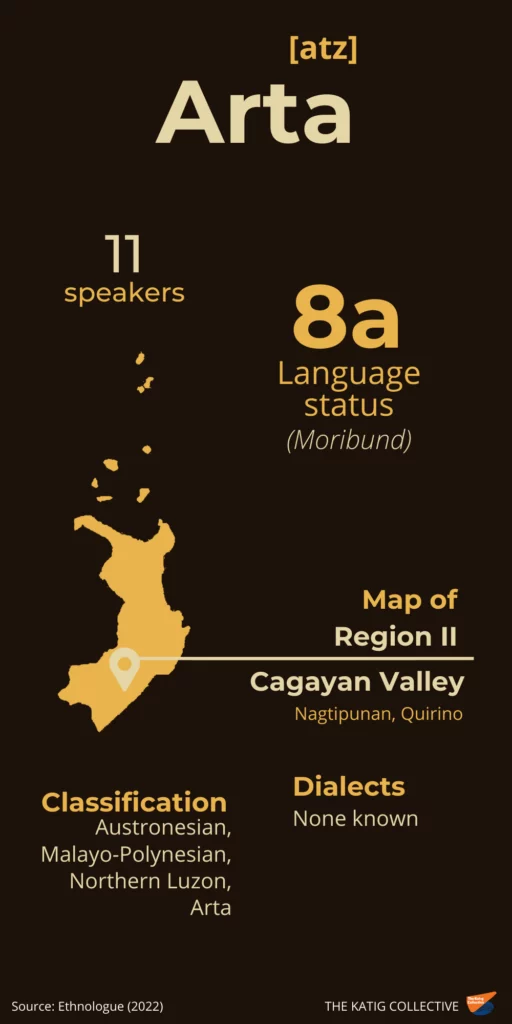Arta
Arta [atz] is spoken by 10 or 11 native speakers and around 35 to 45 second-language speakers in Nagtipunan, Quirino of northern Luzon (Kimoto, 2017a; Kimoto, 2017b). It is a language isolate that belongs to the Northern Luzon subgroup (Endangered Languages Project, n.d.). Considering its current situation and the number of remaining speakers, Arta is labeled as moribund (EGIDS 8a) in Ethnologue (Eberhard et al., 2022). The language is used by Arta natives only among themselves and all speakers belong to the older generation. Several factors that contributed to its endangerment are natural causes, migration, intermarriages, and education.

Natural Causes
One of Kimoto’s language assistants mentioned that there were more than 100 Arta households about half a century ago. A possible cause of population decline is that the Arta people were killed by tamaraws or Mindoro dwarf buffalo (Bubalus mindorensis) which often attack households (Kimoto, 2017a).
Migration
The majority of the remaining households relocated from Disubu, through Aglipay, to Nagtipunan in Quirino. Arta natives became multilingual and can now speak Nagtipunan Agta, Ilocano [ilo], and Tagalog [tgl] (Kimoto, 2017a).
Intermarriages
Intermarriages are very common due to contact with different ethnolinguistic groups, and these unions encourage the Arta people to switch to the languages of the majority instead of using their native tongue. As an example, when an Arta and an Agta marry, their children will be raised as Agta speakers since they use Agta as the primary language at home and in the community (Kimoto, 2017a).

Education
The younger Arta are exposed to Tagalog because they have to learn the language that serves as the medium of instruction in schools. In effect, they only speak a little Arta and frequently borrow from Agta and Ilocano (Kimoto, 2017b).
References
Eberhard, D. M., Simons, G. F., & Fennig, C. D. (Eds.). (2022). Arta. Ethnologue: Languages of the world (25th ed.). https://www.ethnologue.com/language/atz
Endangered Languages Project. Arta. (n.d.). https://www.endangeredlanguages.com/lang/2834
Hammarström, H., Forkel, R., Haspelmath, M., & Bank, S. (Eds.). (2022). Spoken L1 language: Arta. Glottolog 4.6. https://glottolog.org/resource/languoid/id/arta1239
Headland, T. N. (Comp.). (1977). Arta Negrito, Disibu, Aglipay wordlist. SIL International. https://www.sil.org/resources/archives/77199
Kimoto, Y. (2017a). A documentation and description of the Arta language. Endangered Languages Archive. https://www.elararchive.org/dk0411
Kimoto, Y. (2017b). A grammar of Arta: A Philippine Negrito language [Unpublished doctoral dissertation]. Kyoto University. https://zorc.net/RDZorc/ARTA/ARTA_Grammar[Kimoto].pdf
Multilingual Philippines. (2019, September 3). [Opinion] Our languages are in trouble, so what? Rappler. https://www.rappler.com/voices/thought-leaders/239109-philippine-languages-in-trouble-so-what/
Open Language Archives Community. (n.d.). OLAC resources in and about the Arta language. http://olac.ldc.upenn.edu/language/atz
Reid, L. A. (1989). Arta, another Philippine Negrito language. Oceanic Linguistics, 28(1), 47-74. https://doi.org/10.2307/3622974

